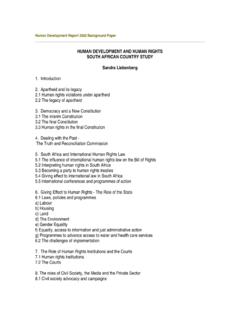Transcription of WHO OWNS THE MEDIA? - Harvard University
1 341[Journal of Law and Economics,vol. XLVI (October 2003)] 2003 by The University of Chicago. All rights reserved. 0022-2186/2003/4602-0014$ OWNS THE media ?*SIMEON DJANKOV,World BankCARALEE MCLIESH,World BankTATIANA NENOVA,World BankandANDREI SHLEIFERH arvard UniversityAbstractWe examine the patterns of media ownership in 97 countries around the find that almost universally the largest media firms are owned by the governmentor by private families. Government ownership is more pervasive in broadcasting thanin the printed media . We then examine two theories of government ownership of themedia: the public interest (Pigouvian) theory, according to which government own-ership cures market failures, and the public choice theory, according to which gov-ernment ownership undermines political and economic freedom. The data supportthe second economies and societies, the availability of information is centralto better decision making by voters, consumers, and of thatinformation is provided by the media , including newspapers, television, andradio, which collect information and make it available to the public.
2 A crucialquestion, then, is how the media should be optimally organized. Shouldnewspapers or television channels be state or privately owned? Should themedia industry be organized as a monopoly or competitively? In this paper,we consider two broad theories of organization of the media and evaluatethem using a new database of media ownership in 97 first theory of the media and of institutions more generally is thepublic interest (Pigouvian) theory, in which governments maximize the wel-fare of consumers. Government ownership of the media , perhaps even as amonopoly, is then desirable for three reasons. First, information is a public* We thank Mei-Ling Lavecchia, Stefka Slavova, and especially Lihong Wang for excellentresearch assistance; Tim Besley, Edward Glaeser, Roumeen Islam, Simon Johnson, LawrenceKatz, Philip Keefer, Aart Kraay, Rafael La Porta, Mark Nelson, Russell Pittman, Andrew Weiss,and Luigi Zingales for comments; and the referee and two editors of this journal for Simons, Economic Policy of a Free Society (1948); and George J.
3 Stigler, TheEconomics of Information, 69 J. Pol. Econ. 213 (1961).342the journal of law and economicsgood once it is supplied to some consumers, it is costly to keep it awayfrom others, even if they have not paid for it. Second, the provision, as wellas dissemination, of information is subject to strong increasing returns: thereare significant fixed costs of organizing information gathering and distributionfacilities, but once these costs are incurred, the marginal costs of making theinformation available are relatively low. Third, if consumers are ignorant,and especially if private media outlets serve the governing classes, then statemedia ownership can expose the public to less biased, more complete, andmore accurate information than it could obtain with private arguments were adduced by the management of the newly formedBritish Broadcasting Corporation (BBC) in support of maintaining a publiclysubsidized monopoly on radio and television in Britain,3and subsequentlyrepeated in many developing contrast, the public choice theory holds that a government-owned mediaoutlet would distort and manipulate information to entrench the incumbentpoliticians, preclude voters and consumers from making informed decisions,and ultimately undermine both democracy and markets.
4 Because private andindependent media supply alternative views to the public, they enable in-dividuals to choose among political candidates, goods, and securities withless fear of abuse by unscrupulous politicians, producers, and , competition among media firms assures that voters, consumers,and investors obtain, on average, unbiased and accurate information. Therole of such private and competitive media is held to be so important for thechecks-and-balances system of modern democracy that they have come tobe called the fourth estate, along with the executive, the legislature, andthe , even the Pigouvian economists, who advocate regulation oreven nationalization by a benevolent government when considering otherindustries, support the free and private Coase points to thishypocrisy of Pigouvian economists: in the very industry where the case forstate ownership is theoretically attractive, they shy away from taking it se-riously.
5 It is hard to believe that the general public is in a better positionto evaluate competing views on economic and social policy than to choose2 Vladimir Lenin, On the Freedom of the Press, 7 Lab. Mon. 35 (1925).3R. H. Coase, British Broadcasting (1950).4 See Amartya Sen, Poverty and Famines (1984); Amartya Sen, Development as Freedom(1999); Timothy Besley & Robin Burgess, The Political Economy of Government Respon-siveness: Theory and Evidence from India, 117 Q. J. Econ. 1415 (2002); and Timothy Besley& Andrea Prat, Handcuffs for the Grabbing Hand? media Capture and Government Account-ability (CEPR Discussion Paper No. 3132, London 2002).5 See Simons,supranote 1; W. Arthur Lewis, The Theory of Economic Growth (1955); andGunnar Myrdal, The Political Element in the Development of Economic Theory (1953).who owns the MEDIA? 343between different kinds of food. 6 Nonetheless, the assumption of benevolentgovernment often stops at the doorstep of the media , perhaps because econ-omists want to protect their own right to supply information without beingsubject to two theories have distinct implications for both the determinants andthe consequences of who owns the public interest theory predictsthat the more benign or public-spirited governments should have higherlevels of media ownership and that the consequence of such ownership isgreater freedom of the press, more economic and political freedom, and bettersocial outcomes.
6 The public choice theory predicts the understand the basic facts about media ownership, and to evaluate thesepredictions, we collect data on ownership patterns of media firms news-papers, television, and radio in 97 countries. Our paper provides a firstsystematic look at the extent of state and private ownership of media firmsaround the world, of the different kinds of private ownership, and of theprevalence of monopoly across countries and segments of the media basic finding is that the two dominant forms of ownership of mediafirms around the world are ownership by the state and ownership by con-centrated private owners, namely, controlling hypothesize that the amenity potential, also known as the privatebenefits of control, 8arising from owning media outlets is extremely other words, the nonfinancial benefits, such as fame and influence, thatare obtained by controlling a newspaper or a television station must beconsiderably higher than those that come from controlling a firm of com-parable size in, say.
7 The bottling industry. Economic theory then predicts thatprivate control of media firms should be highly concentrated: the control ofwidely held firms with a high amenity potential is up for grabs and cannotbe sustained in findings are broadly consistent with described the basic patterns of media ownership, we evaluate thedata in light of the public interest and the public choice theories. We findthat government ownership of the media is greater in countries that are poorer,have greater overall state ownership in the economy, lower levels of schoolenrollments, and more autocratic regimes. The last finding in particular casts6R. H. Coase, The Market for Goods and the Market for Ideas, 64 Am. Econ. Rev. Papers& Proc. 389 (1974).7 See also Simeon Djankov et al., The Regulation of Entry, 117 Q. J. Econ. 1 (2002).8 See Harold Demsetz, The Amenity Potential of Newspapers and the Reporting of Presi-dential Campaigns, in Efficiency, Competition and Policy (H.)
8 Demsetz ed. 1989); HaroldDemsetz & Kenneth Lehn, The Structure of Corporate Ownership: Causes and Consequences,93 J. Pol. Econ. 1155 (1985); and Sanford J. Grossman & Oliver D. Hart, One Share OneVote and the Market for Corporate Control, 20 J. Fin. Econ. 175 (1988).9 Lucian Arye Bebchuk, A Rent-Protection Theory of Corporate Ownership and Control(Working Paper No. 7203, Nat l Bur. Econ. Res. 1999).344the journal of law and economicsdoubt on the proposition that state ownership of the media serves then consider the consequences of state ownership of the media , asmeasured by freedom of the press, political and economic freedom, and healthoutcomes. To this end, we run regressions of a variety of outcomes acrosscountries on state ownership of the media , holding constant various countrycharacteristics. We find pervasive evidence of worse outcomes associatedwith greater state ownership of the media (especially the press).
9 The evidenceis inconsistent with the Pigouvian view of state ownership of the media . Still,since we have only a cross-section of countries, we cannot decisively interpretthis evidence as causal. Other, unmeasured, factors may account for theobserved DataThis section focuses on patterns of ownership in the media industry. Be-cause ownership bestows control,10it shapes the information provided tovoters and consumers. Ownership, of course, is not the only determinant ofmedia content. In many countries, even with private ownership, governmentregulates the media industry, provides direct subsidies and advertising rev-enues to media outlets, restricts access to newsprint and information collec-tion, and harasses journalists. We discuss these modes of control as of the DatabaseWe gathered new data on media ownership in 97 countries. We focusedon newspapers and television since these are the primary sources of newson political, economic, and social on radio ownership are limited.
10 Radio reaches a high proportion ofthe population, even in countries with the lowest levels of income and literacy,but it mainly delivers entertainment. The radio market is also highly regional,which precludes any single station from achieving a large market share. Asa crude index, we gather ownership data on the top radio station as measuredby peak adult audience and on the all-news radio station when one existsin a selection of sample countries is driven by data availability. First, weidentify the countries for which we have information on control we are interested in the consequences of state ownership of the media ,we need to make sure that our results are not driven by differences in eco-nomic development, education, political competition, or state intervention inthe economy. To this end, we control for general levels of state ownershipin the economy, primary school enrollment, autocracy, and gross national10 Sanford J.















